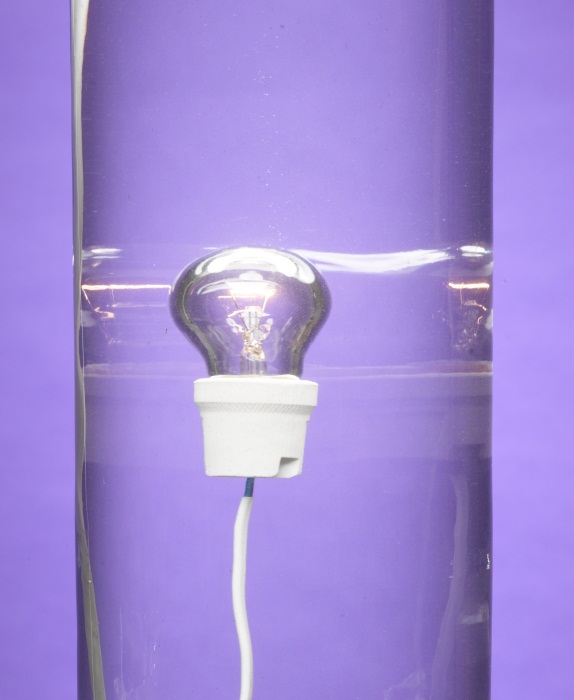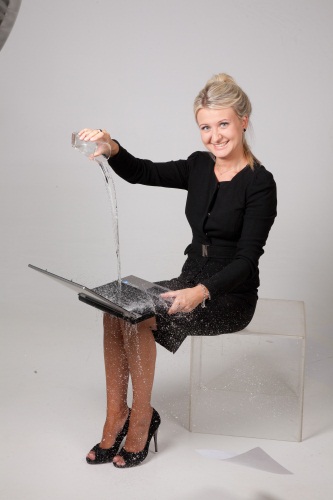Novec 1230 dry water to protect server and not only
Good afternoon, dear habra users! Have you heard of 3M?
We are a company that loves technology and innovation. We think in this we are similar to you. We invented the things that you use every day, but maybe you do not even suspect it! Therefore, we open a small series of articles on 3M products and technologies.

')
Our first post is devoted to Novec 1230 gas extinguishing agent, its history and application.
The story of the employee "first hand".
Can water be dry? Or what is safe extinguishing?
Today, the word “innovation” has become firmly established in our life, it is used so often that it seems to have lost its original meaning. I work at 3M as a member of the technology team for the electronics industry, and every day I come across the amazing world of 3M inventions, some of which you probably already know - sandpaper, Scotch adhesive tape, Post-it leaves.
Bing Crosby’s desire to record his radio programs motivated 3M to create a recording tape that became the standard for a recording and broadcasting studio, revolutionizing the entertainment industry. Neil Armstrong in 1969 made his first step on the moon in shoes, the soles of which were made of Thinsulate material, another invention of 3M. You can talk about our inventions for a long and interesting time, but today I would like to dwell on one of them.
Maybe someone has already heard about the "dry water", saw videos, and which passports and books, a working television, a mobile phone, or an extension cord plugged into the aquarium with water are dipped.
Looks awesome! However, these are not tricks! This “dry water” is nothing more than the innovation of 3M, the gas extinguishing agent Novec 1230, developed by our company for use in gas extinguishing systems, moreover, it is a new class of chemicals used in international practice.

Novec 1230 is absolutely safe for electronics!
I would like to tell about him and his amazing properties. This topic seems especially relevant today, when buildings are built much higher than fire engine stairs can reach, and people do not have the ability to quickly evacuate, expensive servers store invaluable information, there are facilities equipped with sophisticated automation that require the constant presence of operators and continuous operation. equipment, such as airport flight control centers. A simple example is that the controllers of TsUPov have insulating gas masks at their workplaces, in which, in the event of a gas automatic fire extinguishing system based on freon or carbon dioxide, which is deadly dangerous for a person, they must continue to work for 20 minutes before switching the operation of this Control Center to spare.

It is known that the consequences of extinguishing a fire are often as severe as the effects of the fire itself. Water, powder spoil the equipment, the documentation, works of art and all that is valuable in the room; gases - inergen, freon, carbon dioxide affect the material values not so much, but they are deadly for people in the protected premises, therefore they require their immediate evacuation.
In the search for a combination of the parameters of efficiency and safety of fire extinguishing substances over the past decades, several generations of them have been replaced from carbon dioxide and inert gases to chladones. However, most of them have serious limitations on the use. As I mentioned earlier, carbon dioxide systems are deadly to humans, and the first generation refrigerants are banned worldwide due to the enormous negative impact on the atmosphere. And this is an important factor, because global warming is at a record pace. For example, the glacier on Mount Kilimanjaro, which, according to scientists, was supposed to melt by 2015, melted in 2005

Understanding the shortcomings of existing agents for gas extinguishing, a group of 3M scientists did not modify the freons, but directed their efforts to a completely new direction. It was decided to use one of the basic 3M technological platforms - the chemistry of perfluorinated organic compounds. By the way, this technology allows the company to achieve success in the field of ultrafine cleaning of various parts, applying protective coatings on glass, metals and plastics, as well as cooling electronic devices.
The 10-year period of research work was crowned with real success - a new class of gas extinguishing substances - fluorinated ketones was created and introduced into international practice. Numerous tests conducted by the world's leading organizations specializing in fire safety were surprising experts: fluoroketones were not only excellent fire extinguishing agents (with efficiency similar to freon), but also showed a very positive environmental and toxicological profile.
So, fluoroketones. These are synthetic organic substances, in the molecule of which all hydrogen atoms are replaced by fluorine atoms strongly bonded to the carbon skeleton. Such changes make the substance inert in terms of interaction with other molecules. Why “dry” water?
Novec 1230 (FC-5-1-12) (Fluoroketone C-6) is a colorless transparent liquid with a faint odor, which is 1.6 times heavier than water and, most importantly, does not conduct electricity. Its dielectric constant is 2.3 (dry nitrogen is taken as the unit for reference).

Novec 1230 exit from fire extinguishing nozzle
The innovative properties of this extinguishing agent are explained by the structure of its six carbon molecule, which has weak bonds. They allow Novec 1230 to quickly transition from a liquid to a gaseous state and actively absorb the thermal energy of a fire. Fire suppression is carried out due to the cooling effect (70%). Also, a chemical reaction of flame inhibition occurs (30%). At the same time, the concentration of oxygen in the room does not decrease (which is important for increasing the time of evacuation of people from the room). The substance evaporates instantaneously, without entering into chemical reactions, which allows not to cause damage to materials and expensive equipment, and the dielectric properties prevent short circuits.
Another important property of fluoroketones is the extremely low solubility in water, which prevents the substance from passing through the cell membranes into the body, i.e. provides their low toxicity and high heat capacity of vapors, leading to active cooling of the flame and its extinguishing. This means that people who are in the room at the time of operation of the system, are not at risk. Novec 1230-based fire extinguishing systems are equipped with flight control centers at Vnukovo and Koltsovo airports, and dispatchers can do their work when the system is triggered without putting their lives at risk.
I will separately dwell on such a measure as the degree of safety of a fire extinguishing agent for people. It is determined by the difference between the working concentration and the maximum allowable concentration. In world practice, a parameter called NOAEL (No Observed Adverse Effect Level - concentration that does not cause harmful effects) is used. It establishes a threshold concentration of substances for cardiosensitizing and cardiotoxic effects on the body. Sometimes this difference is called the safety margin, which compensates for inaccuracies in the calculation of the amount of gas agent in the system, the uneven distribution by volume of the room, the use of multiplying factors for the calculated concentration and other factors. A negative value of this parameter indicates the danger of the agent in the working concentration after the system has triggered.

Thus, systems using "inert" gases (not supporting combustion) use the principle of extinguishing fire by diluting the air oxygen to values significantly lower than in normal air (12-13% versus 21% in normal air). This leads to the risk of suffocation in people in the room, although such gases do not have a toxic effect. Separately, it should be said about carbon dioxide, for which working concentrations are always fatal to humans. This is due to its physiological effect on the body at concentrations above 5% (for comparison, the standard fire extinguishing concentration for CO2 is 35%).
Chemical agents do not reduce the oxygen concentration in the room. Therefore, for them, the safety factor for staff is the safety factor discussed earlier. For rooms where people may be in need, even if briefly, agents should be chosen with the maximum safety margin.
Now about the environmental component of fire extinguishing substances. Especially in the context of international integration and ratification in the territory of the Russian Federation of documents adopted by the world community. An example is Russia's fulfillment of its obligations under the Montreal Protocol, which led to a ban on the production, import and use in our country of many gas fire extinguishing substances with ozone-depleting properties. The next step is to reduce emissions of agents with high global warming potential, among which a large share is occupied by chladones for fire fighting.
The ratification of the Kyoto Protocol in Russia (Federal Law No. 128-FZ of November 4, 2004 “On Ratification of the Kyoto Protocol to the United Nations Framework Convention on Climate Change”) also provides for a gradual reduction of such emissions.
In 2011, at the UN Climate Change Conference, several countries took the initiative to impose a ban on the use of freon-23 and strict control of consumption and the gradual reduction of emissions of main refrigerants for firefighting (freon-125, freon-227, etc.). Such measures are vital, since otherwise it is simply impossible to keep the process of global warming within the limits determined by scientists as moderately dangerous for the Earth’s climate. The results of these initiatives were not long in coming: the countries of the European Union were the first to introduce these new environmental safety measures. Currently, the relevant amendments to EU legislation are being approved. Other members of the international community are next in line, because the problem of global changes in the climate of our planet is common to all countries.

When Novec 1230 is released into the atmosphere, the fluoroketones are easily destroyed in the upper atmosphere under the influence of ultraviolet, the agent is removed from the environment within 5 days. There is also no cumulative effect characteristic of freons, i.e. the substance does not persist in the atmosphere for decades and even centuries.
For comparison, the release of a gas fire extinguishing installation (GPT) based on freon (348 kg of freon 227) is equivalent to the emission into the atmosphere of 1,008,926 kg of CO2, which is comparable to the annual CO2 emission from 211 cars. The production of a fluorine-based GPT unit (401 kg Novec 1230) is equivalent to a emission of 401 kg CO2 (0.07 cars per year). It can also be commensurate with the emission of carbon dioxide from the livelihood of one cow in one month.
That is why fluoroketone FK-5-1-12 (Novec 1230) was very quickly included in all international and regional gas fire extinguishing standards, making a serious competition to the old class of agents - freons, which have a lot of questions from, both environmentalists and fire protection specialists.
Speaking about the list of objects that can be protected from fire by such installations, it should be borne in mind that, according to Russian and international certificates, installations with GOTV Novec 1230 can extinguish ignition of solid combustible materials, including paper archives without access of firefighters, flammable liquids and equipment under voltage. Thus, practically all tasks of protection of especially valuable objects of the enterprise are covered.

Install Novec 1230
The issue of certification of an agent for extinguishing Class C fires (ie, flammable gases) is being worked out - the last option possible. At the same time, the creation of special conditions for the equipment is not required - the installations can be operated at temperatures from minus 20 ° to plus 50 ° . These are requirements for the location of the cylinders themselves. In the room where the exhaust is produced, the temperature may differ significantly from the given values, both in the smaller and in the larger direction. There are examples of the use of systems at facilities in a harsh climate, in this case, the modules of the system are installed in a heat-insulated compartment.
Summarizing the above, we can state that the final choice of fire extinguishing agent depends on the criteria important for each of us: efficiency and cost, compliance with regulatory and technical standards, safety for humans and the environment. It was these criteria that were followed by the scientists of 3M, creating fluoroketone Novec1230.

The dream of any programmer :)
We hope our story was interesting and informative. We wanted to introduce you to one of the key products of the company in the Russian market.
More information you can find on our website.
You can follow only interesting news by subscribing to our facebook group.
We will be happy to answer any of your questions, and also be happy to hear your comments / suggestions for future publications!
UPD1:
Thanks to Habrayuser Aquahawk for reminding us about the review from the “Galileo” program, we initially decided not to add it in order not to litter the article.
UPD2:
Since a large number of questions and comments are related to the purchase of this product for retail distribution, we would like to explain in more detail the specifics of its use.
Novec 1230 was developed as a gas agent for extinguishing fires in rooms, in its working form it is part of a system that also includes cylinders, piping, and nozzles. In this regard, the supply and packaging of this substance occurs in bulk to manufacturers of equipment, which can be both Russian companies and international, having representative offices in the Russian Federation. They are engaged in the implementation of turnkey systems installation projects specifically for the customer's facilities.
Since the product has no domestic use, we are not able to sell it at retail or for bottling.
Here you can see in more detail and clearly all the stages of the design and installation of the system.
If you have a desire to see the substance live, you can always visit our technical workshop or come to our office and we will demonstrate it to you!
UPD3:
Many thanks to the user BubaVV for an article written overnight about the applicability of Novec 1230 to a computer immersed in liquid .
We are a company that loves technology and innovation. We think in this we are similar to you. We invented the things that you use every day, but maybe you do not even suspect it! Therefore, we open a small series of articles on 3M products and technologies.

')
Our first post is devoted to Novec 1230 gas extinguishing agent, its history and application.
The story of the employee "first hand".
Can water be dry? Or what is safe extinguishing?
Today, the word “innovation” has become firmly established in our life, it is used so often that it seems to have lost its original meaning. I work at 3M as a member of the technology team for the electronics industry, and every day I come across the amazing world of 3M inventions, some of which you probably already know - sandpaper, Scotch adhesive tape, Post-it leaves.
Bing Crosby’s desire to record his radio programs motivated 3M to create a recording tape that became the standard for a recording and broadcasting studio, revolutionizing the entertainment industry. Neil Armstrong in 1969 made his first step on the moon in shoes, the soles of which were made of Thinsulate material, another invention of 3M. You can talk about our inventions for a long and interesting time, but today I would like to dwell on one of them.
Video
Maybe someone has already heard about the "dry water", saw videos, and which passports and books, a working television, a mobile phone, or an extension cord plugged into the aquarium with water are dipped.
Looks awesome! However, these are not tricks! This “dry water” is nothing more than the innovation of 3M, the gas extinguishing agent Novec 1230, developed by our company for use in gas extinguishing systems, moreover, it is a new class of chemicals used in international practice.

Novec 1230 is absolutely safe for electronics!
Interesting? Then more:
I would like to tell about him and his amazing properties. This topic seems especially relevant today, when buildings are built much higher than fire engine stairs can reach, and people do not have the ability to quickly evacuate, expensive servers store invaluable information, there are facilities equipped with sophisticated automation that require the constant presence of operators and continuous operation. equipment, such as airport flight control centers. A simple example is that the controllers of TsUPov have insulating gas masks at their workplaces, in which, in the event of a gas automatic fire extinguishing system based on freon or carbon dioxide, which is deadly dangerous for a person, they must continue to work for 20 minutes before switching the operation of this Control Center to spare.

Why do you need it?
It is known that the consequences of extinguishing a fire are often as severe as the effects of the fire itself. Water, powder spoil the equipment, the documentation, works of art and all that is valuable in the room; gases - inergen, freon, carbon dioxide affect the material values not so much, but they are deadly for people in the protected premises, therefore they require their immediate evacuation.
In the search for a combination of the parameters of efficiency and safety of fire extinguishing substances over the past decades, several generations of them have been replaced from carbon dioxide and inert gases to chladones. However, most of them have serious limitations on the use. As I mentioned earlier, carbon dioxide systems are deadly to humans, and the first generation refrigerants are banned worldwide due to the enormous negative impact on the atmosphere. And this is an important factor, because global warming is at a record pace. For example, the glacier on Mount Kilimanjaro, which, according to scientists, was supposed to melt by 2015, melted in 2005

How did we come up with it
Understanding the shortcomings of existing agents for gas extinguishing, a group of 3M scientists did not modify the freons, but directed their efforts to a completely new direction. It was decided to use one of the basic 3M technological platforms - the chemistry of perfluorinated organic compounds. By the way, this technology allows the company to achieve success in the field of ultrafine cleaning of various parts, applying protective coatings on glass, metals and plastics, as well as cooling electronic devices.
The 10-year period of research work was crowned with real success - a new class of gas extinguishing substances - fluorinated ketones was created and introduced into international practice. Numerous tests conducted by the world's leading organizations specializing in fire safety were surprising experts: fluoroketones were not only excellent fire extinguishing agents (with efficiency similar to freon), but also showed a very positive environmental and toxicological profile.
Some boring chemistry
So, fluoroketones. These are synthetic organic substances, in the molecule of which all hydrogen atoms are replaced by fluorine atoms strongly bonded to the carbon skeleton. Such changes make the substance inert in terms of interaction with other molecules. Why “dry” water?
Novec 1230 (FC-5-1-12) (Fluoroketone C-6) is a colorless transparent liquid with a faint odor, which is 1.6 times heavier than water and, most importantly, does not conduct electricity. Its dielectric constant is 2.3 (dry nitrogen is taken as the unit for reference).

Novec 1230 exit from fire extinguishing nozzle
The innovative properties of this extinguishing agent are explained by the structure of its six carbon molecule, which has weak bonds. They allow Novec 1230 to quickly transition from a liquid to a gaseous state and actively absorb the thermal energy of a fire. Fire suppression is carried out due to the cooling effect (70%). Also, a chemical reaction of flame inhibition occurs (30%). At the same time, the concentration of oxygen in the room does not decrease (which is important for increasing the time of evacuation of people from the room). The substance evaporates instantaneously, without entering into chemical reactions, which allows not to cause damage to materials and expensive equipment, and the dielectric properties prevent short circuits.
How it works?
Another important property of fluoroketones is the extremely low solubility in water, which prevents the substance from passing through the cell membranes into the body, i.e. provides their low toxicity and high heat capacity of vapors, leading to active cooling of the flame and its extinguishing. This means that people who are in the room at the time of operation of the system, are not at risk. Novec 1230-based fire extinguishing systems are equipped with flight control centers at Vnukovo and Koltsovo airports, and dispatchers can do their work when the system is triggered without putting their lives at risk.
How does this affect a person?
I will separately dwell on such a measure as the degree of safety of a fire extinguishing agent for people. It is determined by the difference between the working concentration and the maximum allowable concentration. In world practice, a parameter called NOAEL (No Observed Adverse Effect Level - concentration that does not cause harmful effects) is used. It establishes a threshold concentration of substances for cardiosensitizing and cardiotoxic effects on the body. Sometimes this difference is called the safety margin, which compensates for inaccuracies in the calculation of the amount of gas agent in the system, the uneven distribution by volume of the room, the use of multiplying factors for the calculated concentration and other factors. A negative value of this parameter indicates the danger of the agent in the working concentration after the system has triggered.

Thus, systems using "inert" gases (not supporting combustion) use the principle of extinguishing fire by diluting the air oxygen to values significantly lower than in normal air (12-13% versus 21% in normal air). This leads to the risk of suffocation in people in the room, although such gases do not have a toxic effect. Separately, it should be said about carbon dioxide, for which working concentrations are always fatal to humans. This is due to its physiological effect on the body at concentrations above 5% (for comparison, the standard fire extinguishing concentration for CO2 is 35%).
Chemical agents do not reduce the oxygen concentration in the room. Therefore, for them, the safety factor for staff is the safety factor discussed earlier. For rooms where people may be in need, even if briefly, agents should be chosen with the maximum safety margin.
On the subject of ecology
Now about the environmental component of fire extinguishing substances. Especially in the context of international integration and ratification in the territory of the Russian Federation of documents adopted by the world community. An example is Russia's fulfillment of its obligations under the Montreal Protocol, which led to a ban on the production, import and use in our country of many gas fire extinguishing substances with ozone-depleting properties. The next step is to reduce emissions of agents with high global warming potential, among which a large share is occupied by chladones for fire fighting.
The ratification of the Kyoto Protocol in Russia (Federal Law No. 128-FZ of November 4, 2004 “On Ratification of the Kyoto Protocol to the United Nations Framework Convention on Climate Change”) also provides for a gradual reduction of such emissions.
In 2011, at the UN Climate Change Conference, several countries took the initiative to impose a ban on the use of freon-23 and strict control of consumption and the gradual reduction of emissions of main refrigerants for firefighting (freon-125, freon-227, etc.). Such measures are vital, since otherwise it is simply impossible to keep the process of global warming within the limits determined by scientists as moderately dangerous for the Earth’s climate. The results of these initiatives were not long in coming: the countries of the European Union were the first to introduce these new environmental safety measures. Currently, the relevant amendments to EU legislation are being approved. Other members of the international community are next in line, because the problem of global changes in the climate of our planet is common to all countries.

When Novec 1230 is released into the atmosphere, the fluoroketones are easily destroyed in the upper atmosphere under the influence of ultraviolet, the agent is removed from the environment within 5 days. There is also no cumulative effect characteristic of freons, i.e. the substance does not persist in the atmosphere for decades and even centuries.
For comparison, the release of a gas fire extinguishing installation (GPT) based on freon (348 kg of freon 227) is equivalent to the emission into the atmosphere of 1,008,926 kg of CO2, which is comparable to the annual CO2 emission from 211 cars. The production of a fluorine-based GPT unit (401 kg Novec 1230) is equivalent to a emission of 401 kg CO2 (0.07 cars per year). It can also be commensurate with the emission of carbon dioxide from the livelihood of one cow in one month.
That is why fluoroketone FK-5-1-12 (Novec 1230) was very quickly included in all international and regional gas fire extinguishing standards, making a serious competition to the old class of agents - freons, which have a lot of questions from, both environmentalists and fire protection specialists.
Where can I meet
Speaking about the list of objects that can be protected from fire by such installations, it should be borne in mind that, according to Russian and international certificates, installations with GOTV Novec 1230 can extinguish ignition of solid combustible materials, including paper archives without access of firefighters, flammable liquids and equipment under voltage. Thus, practically all tasks of protection of especially valuable objects of the enterprise are covered.

Install Novec 1230
The issue of certification of an agent for extinguishing Class C fires (ie, flammable gases) is being worked out - the last option possible. At the same time, the creation of special conditions for the equipment is not required - the installations can be operated at temperatures from minus 20 ° to plus 50 ° . These are requirements for the location of the cylinders themselves. In the room where the exhaust is produced, the temperature may differ significantly from the given values, both in the smaller and in the larger direction. There are examples of the use of systems at facilities in a harsh climate, in this case, the modules of the system are installed in a heat-insulated compartment.
Summarizing the above, we can state that the final choice of fire extinguishing agent depends on the criteria important for each of us: efficiency and cost, compliance with regulatory and technical standards, safety for humans and the environment. It was these criteria that were followed by the scientists of 3M, creating fluoroketone Novec1230.

The dream of any programmer :)
We hope our story was interesting and informative. We wanted to introduce you to one of the key products of the company in the Russian market.
More information you can find on our website.
You can follow only interesting news by subscribing to our facebook group.
- Share your opinion, did the pilot article succeed?
- Are you interested in learning more about 3M and its other products?
We will be happy to answer any of your questions, and also be happy to hear your comments / suggestions for future publications!
UPD1:
Thanks to Habrayuser Aquahawk for reminding us about the review from the “Galileo” program, we initially decided not to add it in order not to litter the article.
UPD2:
Since a large number of questions and comments are related to the purchase of this product for retail distribution, we would like to explain in more detail the specifics of its use.
Novec 1230 was developed as a gas agent for extinguishing fires in rooms, in its working form it is part of a system that also includes cylinders, piping, and nozzles. In this regard, the supply and packaging of this substance occurs in bulk to manufacturers of equipment, which can be both Russian companies and international, having representative offices in the Russian Federation. They are engaged in the implementation of turnkey systems installation projects specifically for the customer's facilities.
Since the product has no domestic use, we are not able to sell it at retail or for bottling.
Here you can see in more detail and clearly all the stages of the design and installation of the system.
If you have a desire to see the substance live, you can always visit our technical workshop or come to our office and we will demonstrate it to you!
UPD3:
Many thanks to the user BubaVV for an article written overnight about the applicability of Novec 1230 to a computer immersed in liquid .
Source: https://habr.com/ru/post/200840/
All Articles